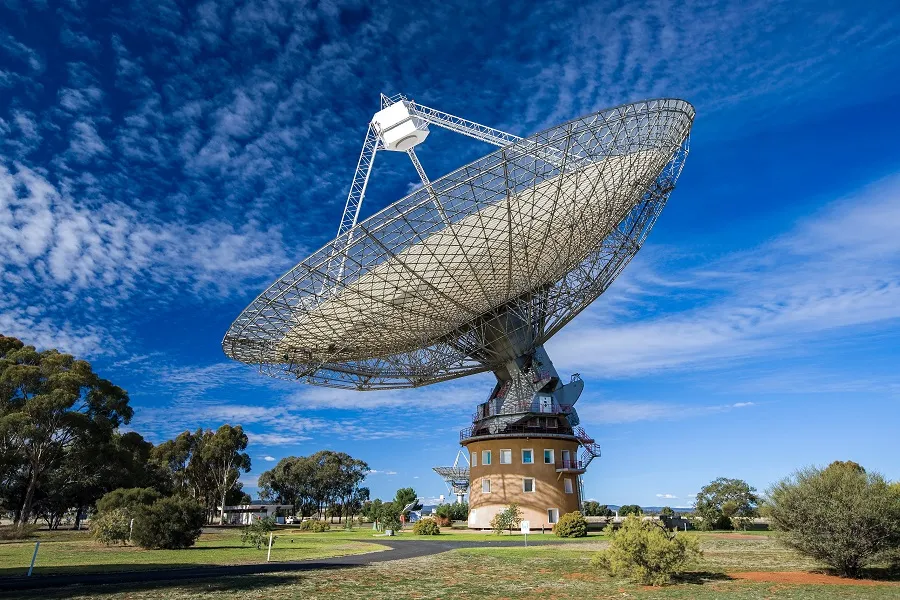
Famous Parkes telescope to again track lunar landings
Mar 24, 2021

The Parkes Telescope, located in New South Wales, Australia, is renowned for its significant contributions to radio astronomy. Recently, this iconic telescope has been repurposed to track lunar landings, enhancing its role in space exploration. With its large dish spanning 64 meters, it is capable of receiving weak signals from distant celestial bodies. The telescope's advanced technology allows it to monitor spacecraft communication, providing crucial data during lunar missions. This revitalized focus on lunar exploration not only pays homage to the telescope's historical achievements but also positions it as a vital asset in the next era of space discovery.
The Parkes Telescope: A Historic Asset in Lunar Exploration
The Parkes Observatory, located in New South Wales, Australia, is renowned for its significant contributions to astronomy and space exploration. Originally built in the 1960s, this iconic telescope has played a pivotal role in various astronomical discoveries. With the resurgence of lunar missions, the Parkes Telescope is set to once again track lunar landings, reigniting interest in its capabilities and historical relevance.
Historical Significance of the Parkes Telescope
When it comes to "lunar exploration", the Parkes Telescope holds a special place in history. It was instrumental during the Apollo 11 mission in 1969, where it received the first live television images of astronauts walking on the Moon. This monumental achievement not only showcased the telescope's advanced technology but also provided a glimpse into the future of space exploration.
The telescope's ability to capture high-frequency radio signals has made it invaluable for various missions, including deep-space explorations. Over the years, it has contributed to numerous discoveries that have expanded our understanding of the universe, including the detection of pulsars and the study of cosmic microwave background radiation.
Modern Advancements and Lunar Tracking
With the renewed interest in lunar missions, including plans for "Artemis" and other international efforts, the Parkes Telescope is being upgraded to enhance its tracking capabilities. These advancements will allow for real-time communication and data transmission during lunar landings, making it an essential tool for monitoring these missions.
The telescope's large dish, measuring 64 meters in diameter, offers a significant advantage in capturing signals from the Moon. As spacecraft approach the lunar surface, the Parkes Telescope will provide crucial data that can aid in navigation and ensure successful landings.
Key Features of the Parkes Telescope
To appreciate the capabilities of the Parkes Telescope, let's take a look at some of its key features:
| Feature | Description |
|---|---|
| Diameter | 64 meters |
| Frequency Range | 0.3 GHz to 100 GHz |
| Primary Purpose | Radio astronomy and lunar tracking |
| Location | Parkes, New South Wales, Australia |
The Role of Collaboration in Lunar Missions
As lunar exploration becomes a global endeavor, collaboration among various space agencies is crucial. The Parkes Telescope will work in conjunction with other observatories and space agencies to provide comprehensive data during lunar missions. These collaborations will enhance the accuracy of tracking and increase the chances of successful landings.
By sharing data and resources, agencies can streamline their operations and minimize risks associated with lunar landings. The Parkes Telescope’s expertise in receiving signals will be a vital asset in this collaborative framework.
Future Prospects for the Parkes Telescope
The future looks promising for the Parkes Telescope as it prepares to take on new challenges in lunar exploration. With the ongoing advancements in technology and the increasing number of lunar missions, the telescope is poised to play a significant role in shaping our understanding of the Moon and beyond.
Moreover, as interest in commercial lunar landings grows, the Parkes Telescope may also provide valuable support to private companies venturing into space. This could open up new avenues for research and development, further solidifying the telescope's place in the landscape of modern astronomy.
Conclusion: A Beacon for Lunar Exploration
The Parkes Telescope stands as a testament to human ingenuity and curiosity. Its ability to track lunar landings highlights its ongoing relevance in the age of space exploration. As we look toward the Moon and beyond, the Parkes Telescope will undoubtedly continue to be a beacon for astronomers and space enthusiasts alike, ensuring that we stay connected to our celestial endeavors.
With its rich history and promising future, the Parkes Telescope is more than just a scientific instrument; it is a symbol of exploration, collaboration, and the quest for knowledge in the universe. As we embark on new lunar missions, the Parkes Telescope will be there, ready to capture the next chapter in our journey to the stars.
Related Articles

Explore Thailand: The Best Islands to Visit for Paradise, Adventure, and Relaxation

The Ultimate Guide to the Best Islands in Thailand for Your Next Getaway

Do babies need passports? How to get a passport for a newborn

How to get a U.S. passport fast: here’s how to expedite the process

What is Mobile Passport Control: 5 reasons why you should use it

SENTRI vs. Global Entry: A detailed guide

Do you need a passport to go to the Bahamas? Let’s find out

Do you need a passport to go to Mexico? A detailed guide

Do you need a passport to go to Canada? We got the answer

Do You Need a Passport for a Cruise: An Essential Travel Guide

Booster Seat Requirements: All the Rules to Follow in Your Rental Car

What Are the World’s Most Powerful Passports, and How Does Yours Rank?

How to Take a Passport Photo at Home: A Helpful Guide

You've got to have heart! Southwest's new livery

Your opinion: Should water be free on low cost carriers?

Young women bolder than guys as solo travellers
